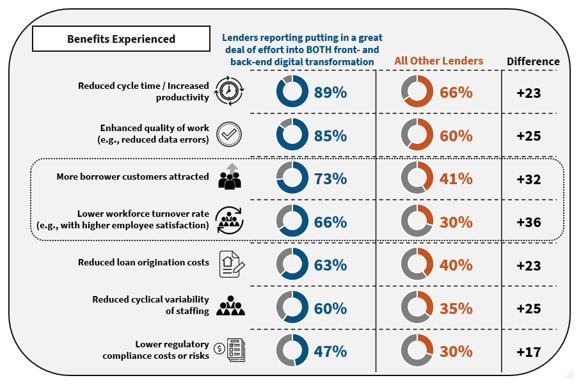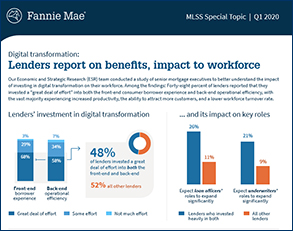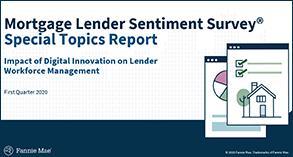Impact of Digital Innovation on Lender Workforce, Now and Looking Forward
More than ever we're seeing how critical technology is to keeping our nation's mortgage ecosystem safely operating. According to Fannie Mae's Mortgage Lender Sentiment Survey®, which surveyed nearly 200 senior executives in the first quarter, lenders who invested "a great deal of effort" in digital transformation reported more benefits, including an uptick in productivity, compared to other lenders. The survey was conducted prior to the swift and unprecedented impact of COVID-19 on society and the economy, and as a result we believe the survey results likely understate the benefits of digital transformation.
Forty-eight percent of lenders reported putting significant effort into both their front-end and back-end digital transformation. These lenders were more likely to: 1) report significant changes to their workforce; and 2) expect loan officers' and underwriters' roles to expand in the near future as their roles become increasingly digital. The same lenders also reported attracting more borrowers and having a lower workforce turnover rate.
Even before the pandemic, an overwhelming majority of lenders (91 percent) said they expect the scope and structure of their workforce to change over the next 2-3 years. Lenders pointed to a trend in which loan officers are moving past simply reviewing borrowers' qualifications to spending more time with customers. For underwriters, lenders see the potential of using automated data extraction to allow them to more quickly examine a potential borrower's entire credit profile, with their role expanded to include a focus on process or compliance. Other lenders are shifting their initial underwriting review to take place immediately after application – before processors even begin working on the loan.
As seen in the chart below, lenders who put a "great deal of effort" into both front-end and back-end digital transformation believe they generate significant competitive advantages compared to other surveyed 1 lenders, including increased productivity, reduced errors, lower turnover rates, and lower costs.

At the same time, role division appears to be less rigid as investment in digital transformation continues. Cross-functional capabilities have been shown to help build employee motivation and reduce staff turnover rate. It may also provide a company with greater staffing flexibility, leading to operational improvements. 2 Though the share of personnel cost to total origination cost has remained over 60 percent over the past decade 3, 81 percent of lenders said they do not believe that it would be beneficial for the mortgage industry to outsource loan origination. As the industry continues to evolve, it is critical for lenders to think strategically about their workforce management practices, including skills, structure, and training, to ensure that staff adapt well to future role changes and deliver new efficiencies. This will be particularly important to help lenders remain competitive as industry-disrupting firms emerge, bringing with them new competitive advantages associated with the re-engineering of past processes and workforce roles.
To learn more, read our Fannie Mae Mortgage Lender Sentiment Survey Special Topic Report, "Impact of Digital Innovation on Lender Workforce Management."
Andrew Peters
VP, Single-Family Strategy & Insights
May 13, 2020
The author thanks Ahmet Hacikura at Oliver Wyman, Colette Porter, Shane Hartzler, Dana Schlafman, Steve Deggendorf, Elizabeth McGaha, and Li-Ning Huang for valuable contributions in the creation of this commentary and the design of the research. Of course, all errors and omissions remain the responsibility of the author.
Opinions, analyses, estimates, forecasts and other views reflected in this commentary should not be construed as indicating Fannie Mae's business prospects or expected results, are based on a number of assumptions, and are subject to change without notice. How this information affects Fannie Mae will depend on many factors. Changes in the assumptions or the information underlying these views could produce materially different results.
1 To examine the impact of lenders' digital transformation efforts on workforce management issues, this study examines the differences between lenders who reported investing "a great deal of effort" in both the front-end consumer borrower experience and the back-end operational efficiency (88 lenders, 48% of the survey sample) versus all other lenders in the sample (95 lenders, 52%).
2 Examples include: "Rewriting the rules for the digital age: 2017 Deloitte Global Human Capital Trends, Deloitte, https://www2.deloitte.com/content/dam/Deloitte/lu/Documents/human-capital/lu-hc-2017-global-human-capital-trends-gx.pdf
"Develop Your Company’s Cross-Functional Capabilities," Harvard Business Review, by Paul Leinwand, Cesare Mainardi, and Art Kleiner, February 02, 2016, https://hbr.org/2016/02/develop-your-companys-cross-functional-capabilities
3 The share of personnel cost to total expenses ranges from 62% in 2011 to 67% in 2019, based on data from Mortgage Bankers Association Quarterly Performance Report, https://www.mba.org/news-research-and-resources/research-and-economics/single-family-research/mortgage-bankers-performance-reports-quarterly-and-annual



